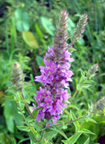|
 |
 |
Invasive Species
Invasive species means an alien species whose introduction does or is likely to cause economic or environmental harm or harm to human health. Invasive species are one of the largest threats to our terrestrial, coastal and freshwater ecosystems, as well as being a major global concern. Invasive species can affect aquatic ecosystems directly or by affecting the land in ways that harm aquatic ecosystems. Invasive species represent the second leading cause of species extinction and loss of biodiversity in aquatic environments worldwide. They also result in considerable economic effects through direct economic losses and management/control costs, while dramatically altering ecosystems supporting commercial and recreational activities. Effects on aquatic ecosystems result in decreased native populations, modified water tables, changes in run-off dynamics and fire frequency, among other alterations. These ecological changes in turn impact many recreational and commercial activities dependent on aquatic ecosystems. Common sources of aquatic invasive species introduction include ballast water, aquaculture escapes, and accidental and/or intentional introductions, among others.

Corbicula fluminea. Often called the Asian clam, this small mollusk can clog intake pipes for cooling water.
Ballast Water
A major concern is the introduction of invasive species through ship ballast water carrying viable organisms from one
waterbody to another. All mainland coasts of the United States - East, West, Gulf, and Great Lakes, as well as the coastal
waters of Alaska, Hawaii, and the Pacific Islands - have felt the effects of successful aquatic species invasions. Over
two-thirds of recent non-native species introductions in marine and coastal areas are likely due to ship-borne vectors,
and ballast water transport and discharge is the most universal and ubiquitous of these. EPA is working in conjunction
with our Federal and State partners to address this source of aquatic invasive species both domestically and
internationally.
|
|
| Features |

Purple Loosestrife. This beautiful plant is highly aggressive in the wild, displacing native vegetation.
Vessel Discharge Permit Program Under Development
Factsheet: Ballast Water and Aquatic Invasive Species
Overview of EPA Authorities for Natural Resource Managers Developing Aquatic Invasive Species Rapid Response and
Management Plans
Economic Impacts of Aquatic Invasive Species Workshop
Memorandum of Understanding Between EPA Office of
Water and the U.S. Coast Guard (PDF)
(6 pp, 201K, About PDF)
Memorandum of Agreement Between EPA Office of
Research and Development and the U.S. Coast Guard (PDF)
(11 pp, 84K, About PDF)
Office of Wetlands, Oceans, and Watersheds Invasive
Species Action Plan Factsheet (PDF)
(1 pg, 81K, About PDF)
OWOW Invasive Species Action Plan (PDF)
(10 pp, 36K, About PDF)
Nonindigenous Aquatic Nuisance Prevention and Control Act (PDF)
(45 pp, 260K, About PDF)
Executive Order 13112 on Invasive Species (PDF)
(4 pp, 68K, About PDF)
Watershed Academy Web: Invasive Non-Native Species
|
|


